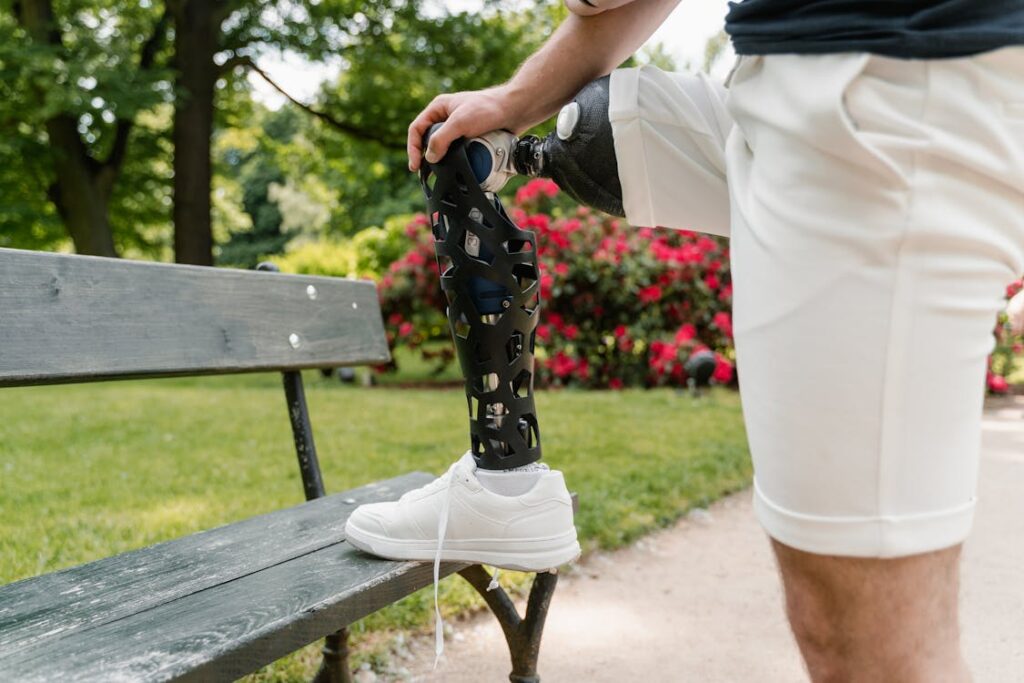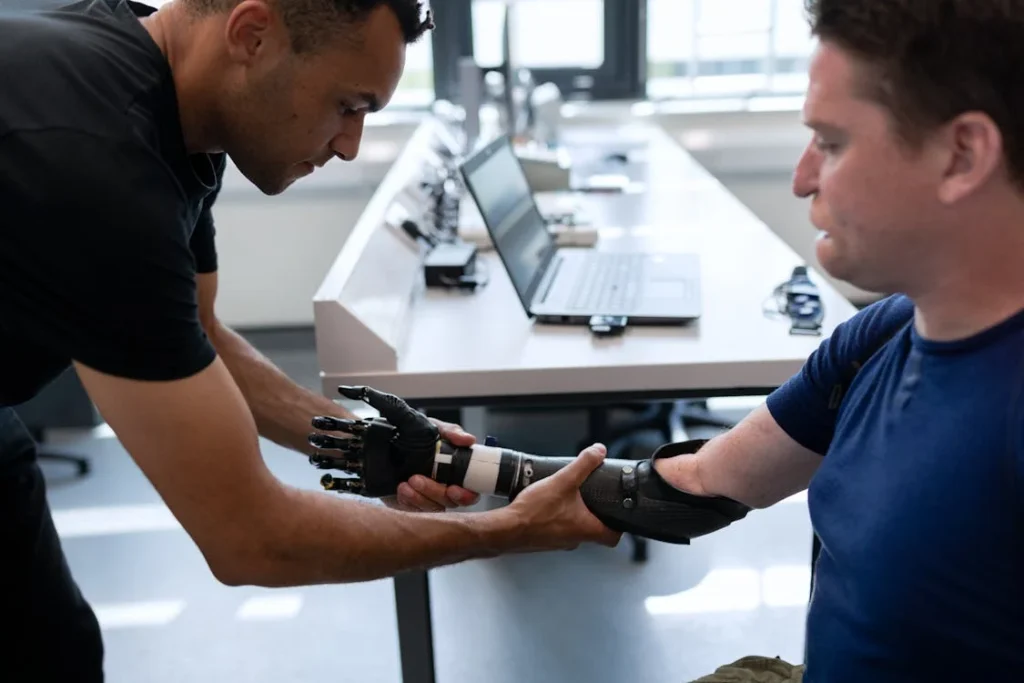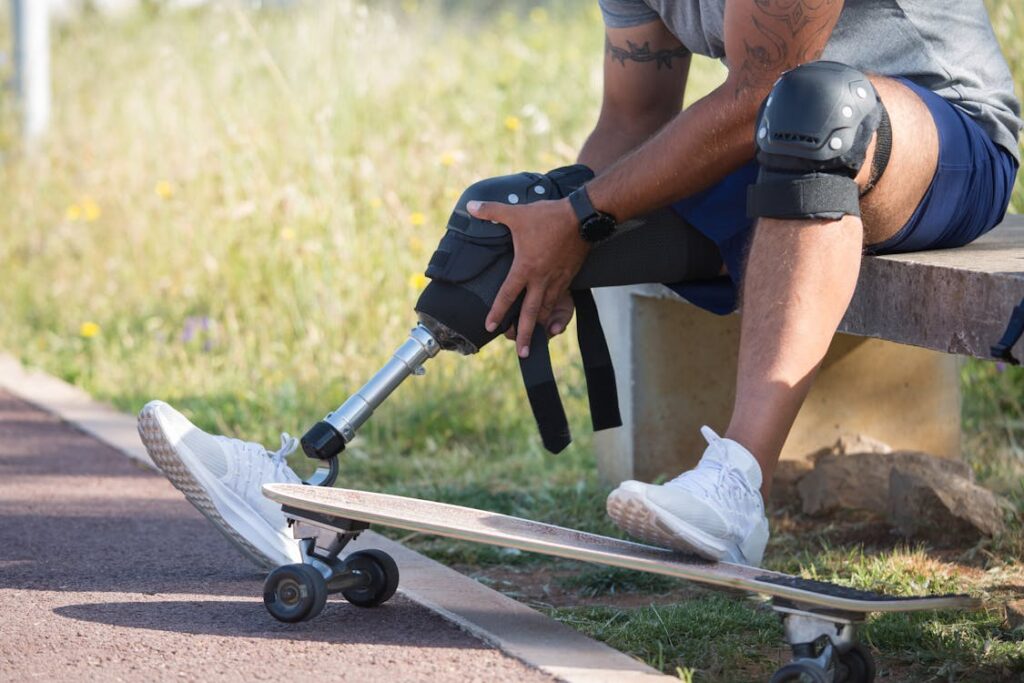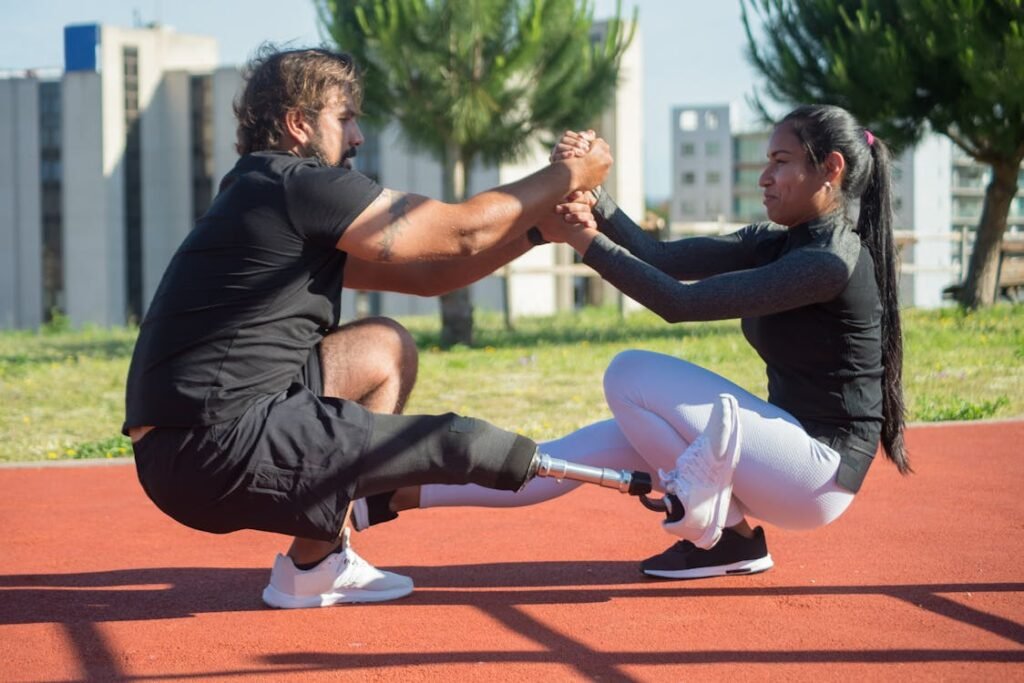Advancements in bionic prosthetics have transformed the way people with limb loss regain mobility and independence. With AI-powered hands, robotic limbs, and sensory feedback technology, the world of prosthetics is moving toward high-tech solutions. However, traditional prosthetics continue to remain relevant and even preferable for many users. While bionic limbs offer cutting-edge features, traditional prosthetics provide durability, reliability, and affordability, making them a strong competitor in the prosthetic industry.
Not everyone needs or wants a robotic limb. For some, simplicity, ease of use, and lower maintenance are more important than having an advanced electronic system. Traditional prosthetics, including mechanical hands and passive limbs, still play a crucial role in restoring function and improving lives. They have stood the test of time because they offer practical benefits that high-tech alternatives sometimes struggle to match.

The Strength of Simplicity: Why Traditional Prosthetics Still Work
One of the biggest advantages of traditional prosthetics is their simplicity. Unlike bionic limbs that rely on electronic components, sensors, and software, traditional prosthetics operate through mechanical or body-powered systems.
This means they do not require batteries, do not need software updates, and are not dependent on technology to function.
Durability and Long-Lasting Performance
Traditional prosthetics are built to last. They are made from strong materials like carbon fiber, metal, and high-quality plastics, which can withstand rough environments, extreme temperatures, and heavy use.
In contrast, bionic prosthetics, while advanced, contain delicate electronic components that can be vulnerable to damage from water, dust, or impact.
Many users, especially those who engage in physically demanding activities, prefer traditional prosthetics because they can handle tough conditions without the risk of malfunction.
Farmers, laborers, and individuals who work in outdoor environments often find that a body-powered or passive prosthetic is more reliable than a bionic one.
Low Maintenance and Easy Repairs
Since traditional prosthetics do not have electronic parts, they require far less maintenance than bionic limbs.
With a bionic hand, users must ensure that the battery is charged, the software is updated, and sensors are functioning correctly. If a component fails, repairs can be expensive and time-consuming.
On the other hand, traditional prosthetics rarely break down unexpectedly, and when they do, repairs are usually straightforward and inexpensive.
A worn-out cable in a body-powered prosthetic can be replaced quickly, whereas a malfunctioning motor in a bionic hand might require specialized service and significant costs.

Affordability and Accessibility: Why Traditional Prosthetics Remain Practical
The cost of prosthetics plays a major role in determining which type of limb a person chooses. While bionic prosthetics offer advanced features and cutting-edge technology, they often come with a high price tag.
Traditional prosthetics, on the other hand, are much more affordable, making them a practical choice for many individuals.
Lower Costs Without Compromising Functionality
Traditional prosthetics are significantly less expensive than bionic limbs because they do not require electronic components, sensors, or specialized programming.
For individuals who need a functional and reliable prosthetic without spending a fortune, a body-powered or passive limb provides an excellent solution. Many users find that traditional prosthetics allow them to regain independence at a fraction of the cost.
Affordability also affects long-term ownership. With bionic limbs, maintenance and repairs can be costly due to the complexity of electronic systems.
Traditional prosthetics require fewer repairs and, when necessary, replacements or adjustments are much more affordable. This makes them a cost-effective choice for individuals who want a long-lasting solution without unexpected expenses.
Greater Availability for a Wider Audience
In many parts of the world, access to advanced bionic prosthetics is limited due to high costs and the need for specialized fitting and calibration.
Traditional prosthetics, however, are widely available and can be fitted much more quickly. For people living in remote or underserved areas, this accessibility is crucial.
Medical professionals and prosthetists can create and fit traditional prosthetic limbs with relative ease, ensuring that users receive the help they need without long waiting periods.
Bionic prosthetics often require specialized training, advanced manufacturing techniques, and specific conditions for fitting and use, making them less practical in certain regions.
The simplicity of traditional prosthetics means they can be made and repaired by a wider range of specialists, ensuring that users can access support when needed.
Insurance Coverage and Financial Assistance
Because traditional prosthetics are more affordable, they are also more likely to be covered by insurance and government programs.
Many healthcare systems prioritize cost-effective solutions, meaning individuals looking for a prosthetic limb may have an easier time getting financial assistance for a traditional prosthetic than for a high-tech bionic alternative.
This can make a huge difference for individuals who need a prosthetic to regain mobility and independence but may not have the means to invest in an expensive bionic limb.
The affordability and accessibility of traditional prosthetics ensure that more people can benefit from prosthetic technology without financial stress.
While bionic limbs continue to push the boundaries of innovation, traditional prosthetics remain a practical, cost-effective, and highly functional choice for many users.

Ease of Use: Why Many Users Prefer Traditional Prosthetics
One of the biggest factors in choosing a prosthetic limb is how easy it is to use in daily life. While bionic prosthetics come with advanced technology and exciting features, they also require time, effort, and training to master.
Traditional prosthetics, on the other hand, offer a straightforward, user-friendly experience that allows for immediate use with minimal learning.
No Need for Training or Calibration
Bionic prosthetics require users to learn how to control the limb through muscle signals or external sensors. This process often takes weeks or even months, as the body needs to adjust to sending the right signals and the prosthetic must be fine-tuned for each individual.
Additionally, some bionic limbs need frequent recalibration to ensure they respond correctly to muscle movements, adding an extra layer of complexity.
Traditional prosthetics eliminate this challenge because they operate through mechanical movement or passive support. Users do not have to undergo extensive training or calibration.
A body-powered prosthetic, for example, is controlled by simple shoulder or upper arm movements that can be mastered quickly.
This makes traditional prosthetics a practical choice for individuals who want a no-fuss solution that allows them to regain function without a steep learning curve.
Reliability in Any Environment
Because traditional prosthetics do not rely on electrical components, they can be used in any setting without concern about damage from water, dirt, or impact.
A bionic prosthetic hand may offer fine motor control and multiple grip patterns, but if it is exposed to water or extreme temperatures, it can malfunction. Users who engage in outdoor activities, sports, or physically demanding jobs often find traditional prosthetics more dependable.
For individuals living in areas with limited access to electricity or advanced medical facilities, traditional prosthetics provide unmatched reliability.
There is no need to worry about battery life, software malfunctions, or finding a technician to fix an electronic issue. The simplicity of a traditional limb ensures that it can be used anywhere, anytime, without fear of unexpected failure.
Comfort and Long-Term Wearability
Comfort plays a huge role in how well a prosthetic limb integrates into a person’s daily life. Many users report that traditional prosthetics are easier to wear for extended periods because they are lightweight and do not contain heavy motors or battery packs.
Bionic limbs, while offering advanced movement, can sometimes feel bulky due to the additional weight of electronic components.
Traditional prosthetics are also designed to be ergonomic, with custom-made sockets that ensure a snug and comfortable fit. Because they do not rely on complex machinery, they place less strain on the body, reducing fatigue during long hours of use.
Many users appreciate the ease of slipping on their prosthetic limb in the morning without needing to charge or adjust it throughout the day.
The combination of simplicity, reliability, and comfort makes traditional prosthetics a practical and appealing choice for many people.
While bionic technology continues to evolve, traditional prosthetics remain a trusted and effective solution for individuals who prioritize ease of use and long-term functionality.

Customization and Adaptability: The Strength of Traditional Prosthetics
A prosthetic limb is not just a tool; it is an extension of the body that must fit seamlessly into a person’s lifestyle. While bionic prosthetics offer high-tech features, traditional prosthetics excel in customization and adaptability.
Many users find that a well-fitted traditional limb can provide the same level of independence and functionality as a bionic alternative, but with far greater flexibility and personalization.
Designed to Fit Individual Needs
One of the biggest advantages of traditional prosthetics is that they can be tailored to suit the user’s specific needs. Every individual has different physical requirements, and a prosthetic must accommodate those needs to ensure comfort and functionality.
Traditional prosthetics are custom-made to match the shape and size of the residual limb, ensuring a secure and comfortable fit. Because they do not rely on electronic components, they can be modified more easily to accommodate changes in body structure or lifestyle.
A person with an active lifestyle may require a durable and lightweight design, while someone with limited mobility may need a prosthetic that provides stability and support.
Traditional prosthetics can be designed with specialized features, such as reinforced materials for heavy lifting or softer padding for increased comfort. This level of customization ensures that the prosthetic is not just functional but also enhances the user’s daily life.
Versatility for Different Activities
Traditional prosthetics are highly versatile, making them suitable for a wide range of activities. Whether a person needs a prosthetic for work, sports, or daily tasks, traditional limbs can be adapted to meet those demands.
Many individuals use different types of prosthetic attachments depending on the activity they are performing. For example, a person may use a basic passive hand for everyday tasks and switch to a specialized prosthetic designed for sports or manual labor.
Bionic prosthetics, while advanced, often come with limitations in adaptability. Many are designed for general use and may not perform well in high-impact activities such as weightlifting, running, or swimming.
Traditional prosthetics, on the other hand, can be modified to support specific activities without the risk of damaging electronic components. This adaptability allows users to engage in a variety of physical activities without worrying about technical failures or restrictions.
Easier Upgrades and Adjustments
As a person’s needs change over time, their prosthetic may need adjustments or upgrades. Traditional prosthetics are easier to modify and repair compared to bionic limbs, which often require specialized software updates and hardware replacements.
If a user experiences changes in weight, muscle growth, or residual limb shape, a traditional prosthetic can be adjusted with simple modifications to ensure continued comfort and functionality.
Because traditional prosthetics are mechanically operated, they do not require complex recalibrations. If a person needs a stronger grip or a different range of motion, a prosthetist can make adjustments to the limb’s design without interfering with electronic components.
This flexibility makes traditional prosthetics a long-term, adaptable solution for users who may experience changes in their physical needs over time.
The ability to customize, modify, and adapt traditional prosthetics to suit individual needs makes them a valuable option for people of all ages and activity levels.
While bionic limbs offer impressive technological advancements, traditional prosthetics continue to hold their own by providing practical, reliable, and highly personalized solutions for those seeking independence and mobility.

The Psychological and Emotional Comfort of Traditional Prosthetics
Choosing a prosthetic limb is not just about function and practicality; it is also about how the user feels when wearing it. Beyond the ability to perform tasks, a prosthetic plays a significant role in a person’s emotional well-being, confidence, and overall quality of life.
Traditional prosthetics continue to be a preferred choice for many individuals because they provide a sense of familiarity, stability, and ease of integration into daily life.
A Familiar and Predictable Experience
For many prosthetic users, familiarity is important. Traditional prosthetics have been around for a long time, and their design has been refined over decades to meet the needs of users in a variety of situations.
People who have used body-powered or passive prosthetics for years often prefer to stick with what they know. The way these prosthetics function is predictable, and users do not have to worry about unexpected malfunctions, recalibrations, or breakdowns.
In contrast, bionic prosthetics, while advanced, can introduce a learning curve. Many users have to spend weeks or months adjusting to how a bionic limb responds, interpreting signals, and troubleshooting minor errors.
Traditional prosthetics, with their simple and direct mechanical function, eliminate this challenge and allow users to feel comfortable from the very first day of use.
This sense of predictability provides peace of mind, allowing individuals to go about their daily routines without additional stress.
Building Confidence in Social Interactions
Social interactions can be a source of anxiety for people with prosthetic limbs. The appearance, movement, and usability of a prosthetic can affect how a person feels in public settings.
Many individuals prefer traditional prosthetics because they offer a straightforward, functional design that does not draw unnecessary attention.
A passive prosthetic, for example, can be customized to match the natural appearance of a limb, helping users feel more comfortable in social environments.
Bionic prosthetics, while offering advanced features, can sometimes feel overly mechanical in appearance or movement. Some users find that the robotic nature of a bionic limb draws more attention than they are comfortable with.
Others may struggle with minor movement delays or calibration issues that can make gestures feel unnatural in social settings. Traditional prosthetics eliminate these concerns by offering a reliable and discreet option that allows users to interact with confidence.
Reducing Stress and Dependence on Technology
Technology has brought incredible advancements to the field of prosthetics, but it also comes with a degree of dependence. Bionic limbs rely on batteries, software, and electronic components, all of which require maintenance and troubleshooting.
For some users, this added layer of complexity creates unnecessary stress. The possibility of a battery running out, a sensor malfunctioning, or a connectivity issue disrupting function can make everyday life more complicated than it needs to be.
Traditional prosthetics remove these concerns entirely. Users do not have to think about charging their prosthetic, updating its software, or worrying about compatibility with digital systems.
The mechanical simplicity of a traditional limb means that it is always ready to use, providing a stress-free experience. For many, this freedom from technology-related concerns is one of the biggest reasons to choose a traditional prosthetic over a bionic alternative.
The emotional and psychological benefits of traditional prosthetics cannot be overlooked. They provide users with stability, reliability, and a sense of confidence that enhances their overall well-being.
While bionic prosthetics continue to push the boundaries of innovation, traditional prosthetics remain a strong choice for those who value familiarity, ease of use, and a dependable solution for everyday life.

Traditional Prosthetics and Their Role in Sports and Physical Activities
For many people with limb loss, staying active is a key part of maintaining physical and mental well-being. Whether it is engaging in sports, exercising, or simply performing physically demanding tasks, a prosthetic limb should support an active lifestyle rather than limit it.
Traditional prosthetics have proven to be highly effective in these areas, often surpassing bionic prosthetics in durability, performance, and ease of use.
Stability and Durability for High-Impact Activities
Traditional prosthetics are known for their strength and resilience, making them an excellent choice for individuals who engage in activities that involve high-impact movement.
Unlike bionic prosthetics, which rely on delicate electronic systems, traditional prosthetic limbs are constructed from durable materials such as carbon fiber, titanium, and reinforced plastics.
These materials allow the prosthetic to withstand intense movement, heavy pressure, and various environmental conditions without the risk of malfunction.
Athletes who participate in running, weightlifting, or extreme sports often prefer traditional prosthetics because they do not have to worry about electronic failures or sensor misreadings.
A body-powered limb, for example, allows users to control their movements with full confidence, knowing that the mechanical system will respond consistently every time. This level of dependability is crucial for those who push their bodies to the limit in training and competition.
Prosthetic Adaptability for Different Sporting Disciplines
Traditional prosthetics can be customized for a wide range of sports and physical activities. Many prosthetic users require specialized attachments or modifications to help them perform specific movements efficiently.
For example, a runner may require a prosthetic with a flexible carbon fiber blade for optimal energy return, while a rock climber may need a specially designed grip to provide better support when scaling surfaces.
Traditional prosthetics allow for these adaptations without the technical limitations that come with bionic limbs.
Bionic prosthetics, while offering advanced technology, often struggle to keep up with the fast-paced and unpredictable nature of sports.
Electronic sensors may not always respond quickly enough to rapid changes in movement, and the added weight of motors and batteries can sometimes affect balance and agility.
In contrast, traditional prosthetics provide a lightweight and adaptable solution that allows users to focus on their performance without distractions.
Low Maintenance for Long-Term Activity
One of the greatest advantages of traditional prosthetics for active individuals is their low maintenance requirements.
When engaging in sports or physical activities, the last thing an athlete wants to worry about is whether their prosthetic will run out of battery, lose calibration, or malfunction due to environmental factors like sweat, dirt, or water exposure.
Traditional prosthetics eliminate these concerns by offering a simple and effective mechanical system that requires minimal upkeep.
Many athletes and active users prefer traditional prosthetics because they can be easily repaired or adjusted without relying on specialized technicians or expensive replacement parts.
If a mechanical joint becomes loose or a strap needs replacing, the fix is straightforward and quick. This ensures that users can stay active without prolonged downtime or disruptions due to technical issues.
Traditional prosthetics continue to play a significant role in enabling individuals to lead active and fulfilling lives.
Whether in competitive sports, recreational activities, or everyday physical movement, these prosthetics provide unmatched durability, adaptability, and reliability.
While bionic prosthetics have made impressive strides in technology, traditional prosthetics remain the preferred choice for many who prioritize strength, performance, and ease of use in their daily activities.
Conclusion
While bionic prosthetics represent exciting advancements in technology, traditional prosthetics continue to prove their worth in everyday life. Their durability, affordability, and reliability make them a preferred choice for many individuals who need a practical and effective solution. Whether it’s their ability to withstand harsh environments, their ease of maintenance, or their adaptability to sports and active lifestyles, traditional prosthetics remain a vital option.
For those who value simplicity, cost-effectiveness, and long-term performance, traditional prosthetics provide unmatched benefits. They eliminate concerns about battery life, software failures, or costly repairs, allowing users to focus on living their lives without technological limitations. Their time-tested design and proven effectiveness ensure they will always have a place in the world of prosthetics.
At Robobionics, we believe that the best prosthetic is the one that meets the user’s needs and enhances their quality of life. Whether through traditional or bionic solutions, our mission is to provide high-quality, accessible prosthetics that restore independence and confidence. If you’re considering a prosthetic and want to explore your options, contact Robobionics today for expert guidance and support.



